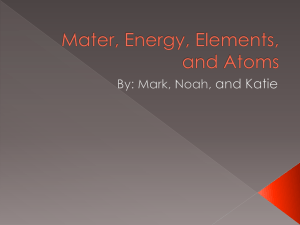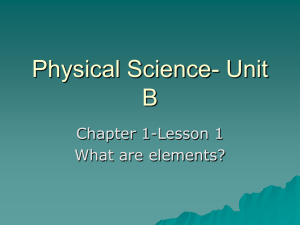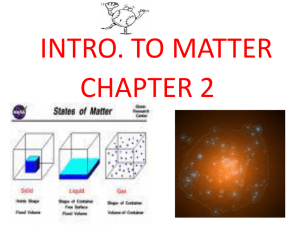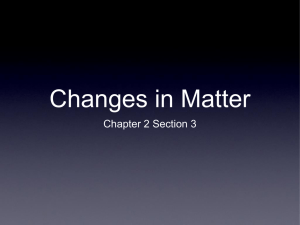Introduction to Matter Unit 2, Cooking
advertisement
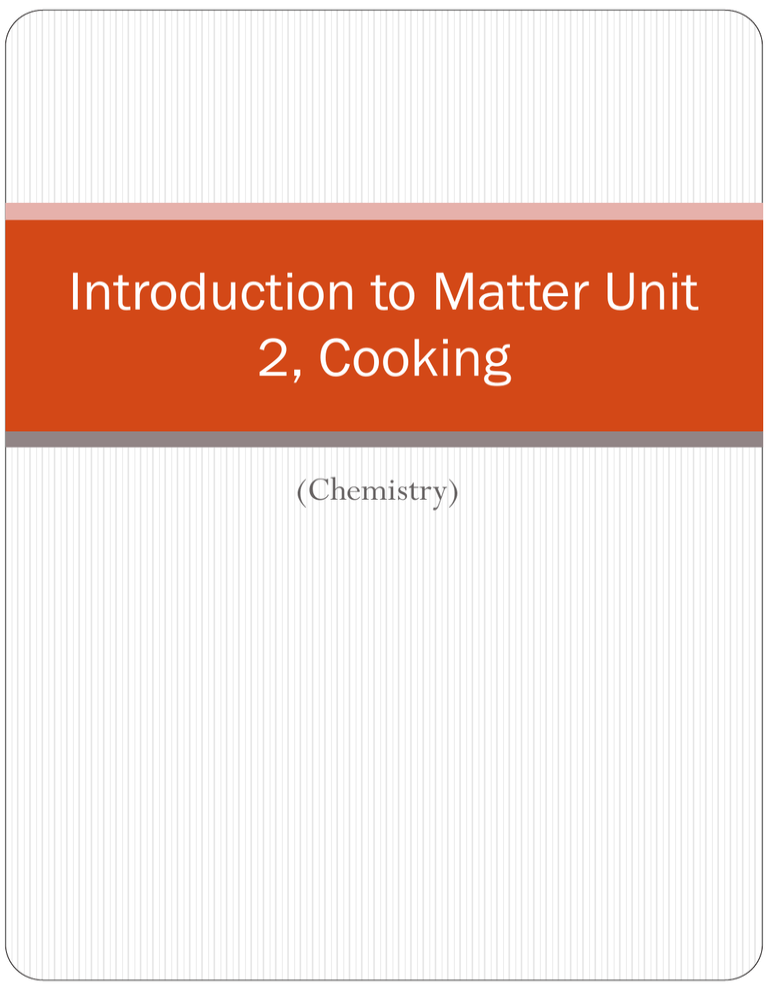
Introduction to Matter Unit 2, Cooking (Chemistry) EQ: What is Matter and How Can it’s Properties be Described? Helpful hints: Go online for crossword puzzles and vocabulary flash cards: phschool.com web code: crj-0002 Helpful hint: Study you vocabulary warm-up notes, or go online to my website for the daily warm-up words regarding matter. Helpful hint: If you like the videos I’ve been showing, they can be found at Stevespanglerscience.com I Describing Matter Matter is anything that has mass and takes up space. Properties of Matter The properties and changes of any type of matter depend on its makeup. A substance is a single kind of matter that is PURE it always has a specific composition and a specific set of properties. Table salt and sugar are examples. If you have a salt shaker at home, all you have in it is salt and nothing else—if you look into a bag of sugar, all you have in that bag is sugar and nothing else. These are NOT substances: Flour, baking powder, milk, eggs, fruit. Every form of matter has two kinds of PROPERTIES…… Physical Characteristic of a pure substance that can be observed without changing it into another substance. Examples: water freezing into ice; hardness, texture, color, solid, liquid, gas, solubility (ability to dissolve) in water , the luster (shininess or dullness of a metal), ability to conduct heat/electricity, magnetic properties, ductility (a metal’s ability to be shaped into useful things like wire or tools); a physical property of oxygen is that it is a gas at room temperature. Chemical A characteristic of a pure substance that describes its ability to change into different substances. Can’t be observed just by looking at or touching a substance. To observe chemical properties, you must try to chnge it into another substance. Examples: A chemical property of methane (natural gas), is that it can catch fire and burn in air. When it burns, it combines with oxygen in the air and forms new substances, water and carbon dioxide. Burning, or flammability, is a chemical property of methane as well as the substances in wood or gasoline. More examples: A chemical property of oxygen is that it combines with iron to form rust. Silver or brass reacts with sulfur in the air to form tarnish. A chemical property of gold is that it does not react easily with oxygen or sulfur. Yeast added to bread dough causes gas pockets in the bread; therefore, bread rises. Elements Go Online to: Scilinks.org Code: scn-1111 A pure substance that cannot be broken down into any other substances by chemical or physical means. Elements are the Simplest Substances. The building blocks more complex forms of matter. Found on the Periodic Table (which can be found in the back of your Agenda, on the Internet, in your textbook, or on my wall). Can be identified by its specific physical and chemical properties. Examples are: Aluminum (soda cans, foil, outdoor furniture); Pennies are made from zinc, another element, and a coating of copper. Oxygen and Nitrogen (in the air you breathe) Often represented by one or two letter symbols, such as C for carbon, and O for oxygen, and H for hydrogen. Elements: Atoms The basic particle from which all elements are made. Different elements (found on the periodic table only), have different properties because their atoms are different. Atoms are modeled, or drawn in different ways. Below is a picture from your book of a spherical model (the drawing with the pencil), and the cloud model—the one with what looks like a group of purple and blue gumballs. The cloud model shows a drawing of the nucleus of an atom, and it’s electron cloud. We’ll dig into this more when we get into our studies of the periodic table. Atoms of most elements have the ability to combine with other atoms. When they combine, they form a chemical bond, which is a force of attraction between two atoms, and the product, in many cases, forms a molecule. Elements: Molecules Groups of two or more atoms held together by chemical bonds. A molecule of water, for example, consists of an oxygen atom chemically bonded with two hydrogen atoms. Two atoms of the same elements can also combine to form a molecule. Oxygen molecules consist of two oxygen atoms. The picture below shows three models of molecules. Math in Science: Ratios A ratio compares two numbers. It tells you how much you have of one item compared to how much you have of another. For example, a cookie recipe calls for 2 cups of flour for every one cup of sugar. You can write the ration of flour to sugar 2:1, or 2 to 1. The chemical formula for rust, a compound made from the elements of iron (Fe), and Oxygen (0), may be written as Fe2O3 . In this compound, the ratio of iron atoms to oxygen atoms is: 2:3; or 2 to 3. This compound is different from FeO, a compound in which the ration of iron atoms to oxygen atoms is 1:1. Got it? What is the ratio of nitrogen atoms (N) to Oxygen (O) atoms in a compound with the formula N2O5? Is it the same as the compound NO2? Highlight Here, 2:5, to find the answer. Describing Matter Compound V. Mixture Two or more substances, Pure substance made of two or more elements chemically combined in a set ratio. When elements are chemically combined, they form compounds having properties that are different from those of the uncombined elements. Example: sulfur (AG) is a yellow solid and silver (S) is a shiny metal. When silver and sulfur combine, they form a compund called silver sulfide (tarnish) (AG2S). Table sugar (C12H22O11) is a compund made of the elements carbon, hydrogen and oxygen. The sweet sugar crystals do not resemble their parent elements, Carbon (looks like charcoal), Hydrogen (a gas), and Oxygen (a gas). May be represented by a chemical formula which shows the elements in the compound and the ratio of atoms. Example: part of the gas you exhale is carbon dioxide, chemical formula CO2. There is one carbon atom, and there are two oxygen atoms. When a symbol stands alone, and does not show the number of atoms next to it, like oxygen does in the formula, the element will have one atom. The one atom in carbon is inferred—just like a variable that stands alone in algebra has a ‘hidden’ one in front of it, an element that stands alone has one ‘hidden’ atom. What is the ratio of atoms in CO? Highlight after the colon to check your answer: 1:1 elements, compunds or both— that are together in the same place but are not chemically combined. Each keeps its individual properties, and the parts of a mixture are not in a combined ratio. Examples: soil, cereal and milk, salad. Each part of the mixture can be separated; with methods like filtration, magnetic attraction, distillation, evaporation and mechanical means. Compounds cannot be separated—they’ve been chemically combined. Two types of mixtures: Homogeneous – you can’t see the different parts. Examples are sugar in water (solution), bubbles in water. Heterogeneous – you can see the different parts. Examples are salad, cereal in milk, chocolate chip cookie dough Measuring Matter Weight Mass Which weighs more, a The measurement of the amount of matter in the pound of feathers or a object. Mass does not change with location, even pound of sand? when the force of gravity Highlight here: They changes. The mass of an ice cream sandwich on the are both the same moon is the same as the weight mass of an ice cream sandwich on earth. Weight is a measure of In science, we do not the force of gravity on measure weight –we measure mass. an object (or you).! The units we most commonly used in our science work are: Kilograms (kg), and grams (g). There are 1,000 grams in a kilogram. A nickel has a mass of 5 grams, and a baseball has a mass of 150 grams. A paper clip is about 1 gram. Measuring Matter Volume The amount of space that matter occupies Units: Liquids: liter (L), milliliter (ml), is 1/1000th of a liter Solids: cubic centimeter (cm³) cm x cm x cm = cm³ 1ml = 1cm³ Volume of a solid is calculated by multiplying the length x width x height (l x w x h). Measuring an irregular object, like a piece of fruit or rock, can be done by submerging the object in a graduated cylinder with water. The water level will rise by an amount that is equal to the volume of the object in milliliters (ml). Density The mass of a material in a given volume. Which has more density, a cubic meter of concrete, or a cubic meter of feathers? Of course, the concrete is more dense. We have the same volume, but the concrete is much heavier than the feathers. Density formula: Density=Mass divided by volume; or: D=m/v Measuring Matter Density (continued) Remember the Sample Problem A small block of wood floats on water. It has a mass of 200 g and a volume of 250cm³. What is the density of the wood? Calculate the density. Does your answer make sense? The density is lower than 1.0g/cm³, which makes sense because the block can float. Remember, the density of water is 1.0g/cm³, and the block of wood is lighter than this. Highlight the bullet point and further below to see solution 200g (mass)/250cm³ (volume) = 0.8 0 g/cm³ demonstrations I did with common kitchen ingredients? On one of them, we did what is in the picture below. The least dense liquid rose to the top, and the most dense stayed on the bottom. . Changes in Matter Physical Change Any change that alters the form or appearance of matter but does not make any substance in matter into a different substance. Physical changes include a change of state, or change of shape or form. Examples: crushing of aluminum Coke cans, mixing sugar in water, an ice cube melting, or water vaporizing Chemical Change A change in matter that produces one or more new substances with properties different from those of the original substances. Reactions are always happens when chemical changes are involved. Examples: Iron in metal combines with oxygen in the air to produce rust (FeO). When methane (CH4) burns, it makes contact with oxygen (O) molecules in the air, and produces carbon dioxide (CO2) gas and water vapor (H2O). The chemical change that occurs with burning, is called combustion. Other processes that result in chemical changes include: electrolosys, oxidation, and tarnishing. The Stevespanglerscience.com videos I showed in class gave us good examples of chemical changes. Also, when I combined baking soda with vinegar in class, you witnessed the result of extreme fizzing, which was a chemical reaction. Changes in Matter Conservation of Mass/Matter Matter is not created or destroyed No mass is either lost or gained during a chemical change. If you could collect all of the carbon dioxide (CO2) and water produced when methane gas (CH4) burns, and you measured the mass of all the matter collected, you would find that it is equal to the mass of the original methane plus the mass of the oxygen that was used in the burning. See picture below. No mass is lost, because during a chemical change, atoms are not lost or gained, only rearranged. Changes in Matter Matter and Thermal Energy Energy is the ability to do work or cause change. Every chemical or physical change in matter includes a change in energy. Even bending a paper clip takes energy. When ice changes to water, it absorbs energy from the surrounding matter. When candle wax burns, it gives off energy. Temperature is a measure of the average energy of random motion of particles of matter. The particles f gas in the warm outside air have greater average energy of motion than the particles of air in the cool building. Thermal energy is the total energy of all of the particles in an object. Temperature and thermal energy are not the same. Thermal energy always flows from warmer matter to cooler matter. When matter changes, the most common form of energy released or absorbed is thermal energy. For example, ice absorbs thermal energy from its surroundings when it melts. Changes in Matter Thermal Energy (cont’d) Endothermic Change Exothermic Change A change in which An exothermic energy is taken in. Examples: Melting of ice, cooling of hot chocolate or soup. change releases energy. Examples: burning of a fire, burning of a candle; or any combustion. Also think of how a lightbulb gives off heat and light. States of Matter: Solids, Liquids and Gases Solids, Liquids and gases may be elements, compounds, or mixtures. Gold is an element, water is a compound that can be solid, liquid or gas. Air is a mix of gases. The states of matter are defined by whether or not they hold their volume and shape. http://studyjams.scholastic.com/studyjams/ Copy this link into your jams/science/matter/solids-liquidsbrowser for an overview gases.htm States of Matter *Quick overview of the 3 most common states* Solids Liquids Gases Definite shape and volume No shape of its own, definite volume No shape of it’s own (like a liquid), no volume of its own. Particles packed very close, tight and fixed. This causes the definite shape and volume. Particles are free to move around each other, but packed together. Particles are spread out, and not packed together. The dimensions do not change. Dimensions change with container, but the volume remains the same. Gases roam freely, and can be kept in a container like water can Measured in cm³ or m³ Measured in ml or L same volume as its container. lxwxh # of ml # of ml or cm³ States of Matter Solids, Liquids, Gases (Cont’d) Solids: Crystalline: Particles form a regular, repeating pattern which forms crystals. Examples: salt, sugar, snow. When heated, crystalline solids melt as a specific temperature. Amorphous solid: Particles are not arranged in a regular pattern. Examples: butter, rubber, glass. Do not melt at a distinct temperature. May become softer or change into other substances. Liquids: Also called a fluid—substance that flows Fluids have certain characteristics: Surface Tension – inward pull among the molecules of a liquid that brings the molecules on their surface closer together. The surface of water can act like a sort of skin. Viscosity – A liquid’s resistance to flowing. A liquid’s viscosity depends on the size and shape of its particles and the attractions between the particles. The quicker the flow, the higher viscosity. *Gases: * Gases are actually a form of fluid. As particles move, gas particles spread apart, filling all available space. As temperature increases, pressure increases *States of Matter--Changes of State* Why does ice cream melt? Particles of a substance at a warmer temperature have more thermal energy than particles of that same substance at a cooler temperature. Thermal energy always flows as heat from a warmer substance to a cooler substance. Particles of a substance at a warmer temperature have more thermal energy than particles of the same substance at a cooler temperature. Matter changes state when thermal energy is added or removed. Particles in a solid substance vibrate faster when energy is added. The addition of energy causes particles of a solid to move faster and faster until they break free from their fixed position. Liquid particles move more slowly as energy (heat) is removed until they form the regular patterns of a solid. The point where the particles of a solid break free from their fixed positions, is called the melting point. Different substances have different melting points because they have different arrangements of particles that respond differently to added thermal energy. Paste this link http://articles.washingtonpost.com/2009-06into your browser 29/news/36778299_1_national-ice-cream-day-cookieto read an article: dough-large-ice-crystals Solid to Liquid & Liquid to Solid Liquid to Gas & Gas to Solid to Gas & Gas Liquid to Solid Called melting or freezing. Melt at a specific temp. called a melting point. Added thermal energy makes liquid molecules vibrate faster, raising their temperature. At its melting point, the particles are vibrating so fast that they break free from their fixed positions. As ice cream Called vaporization and condensation. Vaporization happens when the particles in a liquid gain enough energy to form a gas. The movement States of Matter – changes of states Changes of state at a glance or an iceberg melts—or anything, for that matter, melts, its molecules absorb heat energy and move further apart. Freezing is a change from liquid to solid. Particles of a liquid move so slowly that they begin to form regular patterns. When water freezes, its temperature remains at 0ºC until freezing is complete. As particles freeze, its molecules lose heat energy and move slower and closer together. of molecules increase as temperature stays the same. Condensation is the opposite of evaporation/vaporization. Evaporation only takes place on the surface of the liquid. Boiling takes place when a liquid changes to gas below its surface and at its surface. The boiling point of a substance depends on the pressure of the air above it. The lower the pressure, the less energy needed to boil liquids. In mountainous areas, the boiling point of water is 95ºC. In Atlanta, GA, the melting point is 100ºC, because Atlanta is much closer to sea level Changes of state usually involve transitioning from a solid to a liquid, then a gas (think of an ice cube melting and evaporating). Sometimes, though, the transition is directly from a solid to a gas. Sublimation occurs when the surface particles of a solid gain enough energy that they form a gas. An example is dry ice. When dry ice becomes a gas, it cools water vapor in the nearby air. The water vapor then condenses into a liquid forming fog around the dry ice. * States of Matter – Gas Behavior How does a hot air balloon fly high in the sky and come back down to earth? It’s secret is in the gas. : ). The balloon is inflated using powerful air fans, then the air is heated with propane gas burners. Remember, air is a gas. Heating causes the air inside the balloon to expand. Some of the warm air leaves through the bottom of the balloon, keeping the pressure constant. The balloon is secured by ballasts ( anchors). When the pilot is ready to lift off, the ballasts are brought into the balloon’s basket, and the balloon rises because the hot air inside the balloon is less dense than the outside air. To descend, the pilot slowly reduces the flame, making the air in the balloon cooler. The air in the balloon gradually becomes more dense than air, so the balloon descends. States of Matter – Gas Behavior * When working with gas, it is helpful to know its volume, temperature and pressure. Volume: The amount of space matter fills Measured in cubic centimeters (cm³), milliliters (ml), and Liters (L) and other units. The volume of a gas is the same as the volume of container that it’s in. Temperature: The average energy of the random movement of particles of a substance. The faster the particles, the greater their energy and the higher temperature. You might think of a thermometer as a speedometer for molecules. Particles of a typical gas at room temperature travel at about 500 meters per second! Pressure: Gas particles are constantly colliding with one another and with the walls of their container. As a result, the gas pushes on the walls of the container. The pressure of the gas is the force of its outward push divided by the area of the walls of the container. Pressure is measured in units of pascals (Pa) or kilo-pascals (kPa). The firmness of a gas-filled object comes from the pressure of the gas. The air inside a fully pumped basketball has a higher pressure than the air outside. This higher pressure is due to a greater concentration of air inside. When air leaks out of a basketball, pressure decreases. The pressure inside drops until it equals the pressure outside of the ball. The formula for pressure is: Pressure = Force/Area Example: A machine exerts a force of 252N on a piston having an area of 0.430 m². What is the pressure on the piston in Pa? Pressure =252N/0.430m² = 586 Pa Watch this to 9:15 for an explanation of gas pressure: http://www.youtube.com/watch?v=90E2jhDVCSg States of Matter – Gas Behavior * Pressure and VOLUME When pressure of a gas at constant temperature increases, the volume of the gas decreases. When pressure increases, volume decreases. Graphing Boyle’s Law* States of Matter – Gas Behavior* Pressure and TEMPERATURE When the temperature of a gas at constant volume is increased, the pressure of the gas increases. When the temperature is decreased, the pressure of the gas decreases. (constant volume means that the gas is in a closed, rigid container). States of Matter – Gas Behavior* VOLUME and TEMPERATURE Graphing Charles’s Law* Law of Conservation of Mass/Matter *The principle that the total amount of matter is neither created nor destroyed during any chemical or physical change. Law of Conservation of Mass/Matter* Suppose you could collect all of the carbon dioxide and water produced when methane gas burns. Methane gas is commonly used as a fuel for a kitchen range (stove). You would find that your collection would equal the mass of the original methane gas, plus the amount of Oxygen that was used to burn the methane. No mass is lost because during a chemical change, atoms are not lost or gained, only rearranged. (p. 53) Another example: In a chemical reaction, carbon (C) and oxygen (O) combine the mass of the product is equal to the mass of the carbon and the mass of the oxygen. How does the law of conservation of mass apply to a burning candle? When a candle burns, the mass of the wick, candle, wax and oxygen that helped the flame before the reaction equals the mass of the smoke, ash and gas after the reaction. No mass is lost, it’s just transformed into different forms of mass. Helpful links: http://www.youtube.com/watch?v=dExpJAECSL8 http://www.neok12.com/php/watch.php?v=zX780d5 e7806764057657b45&t=Law-of-Conservation Summarizing Gases Follow this link by using control+click: http://www.chem.purdue.edu/gchelp/atoms /states.html http://www.youtube.com/watch?v=zvh9uv2 Hxx4 http://www.stevespanglerscience.com/lab/vi deos#?video=water-balloon-in-bottle http://www.stevespanglerscience.com/lab/vi deos#?video=balloon-powered-car
